
17 minute read
Alkylated Naphthalenes for High Temperature Applications
Maureen E. Hunter, Ph.D. King Industries, Inc., Norwalk, CT, USA mhunter@kingindustries.com
Sachin Kumbhar Environ Specialty Chemicals Pvt. Ltd., Mumbai, India sachin@environchem.com
This paper was given an honorary slot at the 2019 NLGI Meeting because the original presentation was awarded Best Technical Paper at the 2019 NLGI-India Meeting.
Abstract
Alkylated naphthalenes are multifunctional, high performance base fluids available in a diverse ISO viscosity range from 22 to 193 cSt at 40°C. They are typically used as a co-base stock in oil and grease formulations to replace a portion of petroleum or PAO base oil.
This paper highlights some selected results for high temperature applications, including chain lubrication, an in-house panel coker test, plywood manufacturing, and greases, that show how alkylated naphthalenes extend the lifetime of high-performance lubricants by improving their thermal and thermo-oxidative stability, decreasing their volatility, and providing excellent dispersion and varnish control for system cleanliness.
Introduction
Alkylated naphthalenes are classified by the American Petroleum Institute (API) as part of the Group V base oil category. However, alkylated naphthalenes are rarely used as the sole base fluid. They are typically incorporated into lubricant formulations to replace a portion of a Group II, Group III, or PAO base oil. This is done to extend the lifetime of high-performance lubricants by:
Improving the thermal and thermo-oxidative stability Enhancing the solubility and response of additives Imparting seal swell Decreasing volatility Providing varnish control for system cleanliness
Previously, many results demonstrating these performance benefits using various bench tests have been reported for liquid lubricants and greases containing alkylated naphthalenes. [1,2]
Most alkylated naphthalenes also have approvals for NSF HX-1 incidental food contact.
Naphthalene Ring
Figure 1 shows that the alkylated naphthalene molecule consists of two fused six-member rings with alkyl groups attached. It is the electron-rich ring structure that imparts the performance enhancing properties, notably in non-polar fluids. The ability of the naphthalene ring to absorb energy, resonate,
and then disperse that energy, much like antioxidants, gives alkylated naphthalenes their inherent excellent thermal and thermo-oxidative stability. The naphthalene ring also provides the polarity for imparting additive solubility, seal swell, and varnish retardation.
Figure 1: Alkylated Naphthalene Structure
The core naphthalene system consists of two fused six-membered rings with an electron-rich conjugated π system.
R1 to R 8 are independently linear or branched alkyl groups or hydrogen.
Alkyl Chains
The alkyl groups control most of the physical characteristics of alkylated naphthalenes. In Figure 1, each substituent (from R1 to R8) can be a linear or branched alkyl group or a hydrogen atom. By carefully controlling the type of alkylating agent used and the degree of alkylation, the chemical and physical properties of alkylated naphthalenes can be significantly influenced. [3,4]
Products
For flexibility in formulating lubricants for a variety of applications, alkylated naphthalenes are available in a diverse viscosity range from about 22 to 193 cSt at 40°C and from about 4 to 20 cSt at 100°C. As shown in Table 1, increasing the viscosity also increases the viscosity index, the aniline point (which means the polarity decreases), the flash point, and the pour point while significantly decreasing the volatility.

Table 1: Alkylated Naphthalene Properties
Applications
Alkylated naphthalenes are used by lubricant formulators to meet demanding requirements for a wide variety of applications including:
Automotive and Stationary Engine Oils Automotive and Industrial Gear Oils High Temperature Chain Lubricants Paper Machine Oils Hydraulic Oils Circulating Oils / Turbine Oils / R&O (Rust and Oxidation) Oils Screw Compressor Oils Heat Transfer Oils Windmill Oils Conveyer Belt Oils for Presses Automotive and Industrial Greases
High Temperature Chain Lubrication
High temperature chain lubrication is a prime example of how alkylated naphthalenes can extend the lifetime of a high temperature lubricant by reducing the volatility to retain the fluid longer and by imparting thermal and thermo-oxidative stability to inhibit viscosity increase and varnish formation.
Chain lubricants are used in many applications where the temperatures can range from less than 150 to greater than 600°C, including:
Transportation (<150°C) Agriculture (<150°C) Mining (<150°C) Bakeries, where approvals for incidental food contact are required (between 150 and 220°C) Automotive coating plants (between 180 and 250°C) Beverage can-coating plants (between 180 and 250°C) Manufacturing of plywood, textiles, ceramics, and plastic films (between 220 and 300°C) Kilns for making pottery, brick, and cement (>600°C)
Alkylated naphthalenes are typically used in applications where temperatures range up to 300°C.
Typical chain lubricant formulations contain a thickener, a tackifier such as polyisobutylene (PIB) to improve adhesion, and a viscosity index improver. They may also include antioxidants, usually combinations of aminics and phenolics, various EP/AW additives, corrosion inhibitors to protect iron and copper, and a defoamer.
Experimental Results
In this study, testing was conducted to determine if the addition of alkylated naphthalene to various chain lubricant formulations would help improve their high temperature performance. In a simple test, three grams of test fluid were placed in an aluminum pan and heated in an oven at 260°C for 8 hours. Afterward, the evaporation loss and condition of the fluid were determined.
Table 2 shows how the addition of AN-19 alkylated naphthalene to a polyol ester (POE), which is an oil recommended for use in high temperature chain lubricants, reduced the evaporation loss to retain the fluid longer. Both the polyol ester alone and the ester with 3% of a 50:50 antioxidant blend of alkylated diphenylamine and phenyl-alpha naphthylamine resulted in 94% evaporation loss. Replacing 20% of the polyol ester with the alkylated naphthalene significantly reduced the evaporation loss to 71%. The addition of the 3% antioxidant blend had essentially no effect on evaporation. Table 2: Reduction of Evaporation Loss to Retain Fluid
AN-19 alone has an evaporation loss of 43%.

* POE 1963 is an ISO VG 68 polyol ester recommended for high temperature chain lubricants (180–300°C). † AO Blend is a 50:50 mixture of alkylated diphenylamine with phenyl-alpha naphthylamine.

Table 3 compares evaporation loss of POE (94%) and AN-19 (43%) individually under the same test conditions. Theoretical evaporation loss was calculated at 84% for 80% POE / 20% AN-19 based on the weighted average of losses. However, the observed evaporation loss was 71%, indicating that there was a synergy between POE and AN-19 that helped to reduce the evaporation loss and retain the fluid longer. Table 3: Evaporation Loss Results
Another formulation was tested, as shown in Table 4, where 12% of the polyol ester was replaced with PIB thickener and tested with and without 3% of the antioxidant blend. The addition of PIB had no effect on the evaporation loss, which was essentially the same as the polyol ester alone at 94% loss. Again, replacing 20% of the polyol ester with alkylated naphthalene significantly reduced the evaporation loss to 69%, and the 3% antioxidant blend had no effect. It was also observed that the addition of the PIB to the polyol ester with no alkylated naphthalene (Blends 5 and 6) resulted in hazy fluids, while the addition of the 20% alkylated naphthalene eliminated the haze, resulting in clear solutions (Figure 2).
* POE 1963 alone had an evaporation loss of 94%.
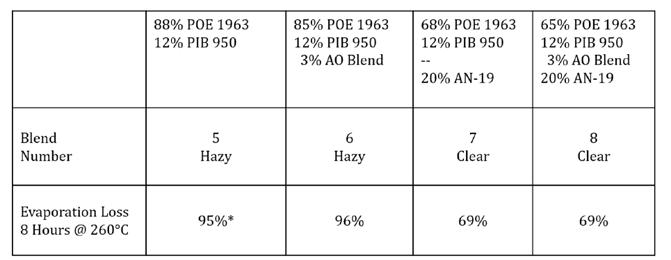
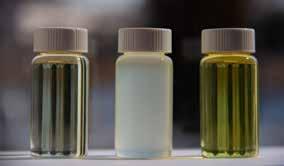
Figure 2: Appearance of Blends
The ester alone was clear (left). When 12% PIB was added to the ester, the sample became hazy (middle); however, when 20% alkylated naphthalene was added in combination with PIB, the blend remained clear (right).
Before aging, all fluids flowed easily. Figure 3 shows that after aging at 260°C for 8 hours, all samples without AN-19 resulted in a thin, hard varnish that was not self-healing when scratched. However, all the samples with AN-19 resulted in less evaporation and left thicker, and therefore darker, samples that remained fluid and functional. Figure 4 shows that the samples containing the AN-19 were selfhealing when scratched, and Figure 5 demonstrates flow after aging.
Figure 3: Varnish Formed by Blends Without Alkylated Naphthalene
The samples without AN-19 created a thin, hard varnish on the metal surface and were not selfhealing when scratched.
The samples that contain AN-19 showed an increase in viscosity after being heated but were still fluid and self-healing when scratched.
Figure 5: Alkylated Naphthalene Blends After Aging
The samples that contain AN-19 flowed after aging.
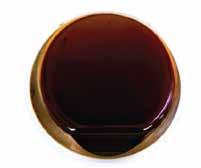
Chains were also dipped in the 100% polyol ester and the 80% ester / 20% AN-19 blend and then allowed to dry overnight. The chains were then pushed into an accordion shape, baked for 8 hours at 260°C, and then their post-bake hanging performance was observed. Figure 6 shows the chain on the left (lubricated with 100% polyol ester) was covered in solid varnish at the end of the test, and the chain remained frozen in place when hung. The chain on the right (lubricated with the POE / AN-19 blend) was covered in a viscous liquid at the end of the test; that liquid continued to lubricate, and the chain fully extended within 2 seconds when hung.
Figure 6: Extended Service Life of a POE Containing 20% AN-19
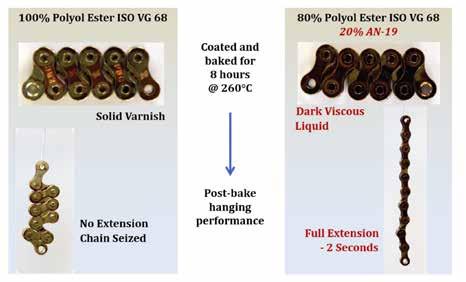
In-House Panel Coker Test
An in-house panel coker test was designed to evaluate the thermo-oxidative properties of formulated fluids by measuring the deposit formation on stainless steel panels after applying a constant flow of test fluid for 18 hours, which created a thin film at elevated test temperatures. The test rig was housed in a high temperature oven and was designed to drip a test fluid at a controlled flow rate onto a panel surface, both of which were held at the same test temperature. The temperature and surface angle of the panel were adjustable.
Using a syringe pump, the fluid was pumped through a 1-mm-thick stainless steel tube, which was contained in the oven, and dripped onto the surface of a cleaned, pre-weighed panel. The flow rate was set to 0.8 mL/hour, and the test was run for 18 hours (14.40 mL total fluid delivered). After the test, the oven was allowed to cool, and the panel was weighed again before being cleaned in a heptane vapor degreaser for 1 hour.
Two values were calculated:
Total Deposit: The combined weight of soft and hard deposits remaining on the panel at the end of the 18-hour test was reported as a weight percentage of the total fluid delivered.

Cured Deposit: The weight of remaining deposit after the panel was degreased was reported as a weight percentage of the total deposit.
A model bakery chain formulation was used for evaluation. It was based on PAO blended to ISO VG 220. Portions of the base fluid were replaced with AN-19, and all blends were treated with 2.5% HX-1 additives including: triphenyl phosphorothionate, alkylated diphenylamine, ashless dithiocarbamate, butylated hydroxytoluene, and calcium sulfonate.
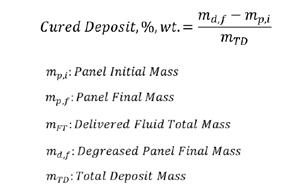
As the PAO base fluid was partially replaced with 10% increments of AN-19 up to 30%, there was a significant decrease in both total deposits (Figure 7) and cured deposits (Figure 8) compared to the PAO formulation alone. Additionally, the panel appearance showed deposit patterns with less coke buildup along the edge of the fluid flow path and a reduction in varnish formation with the incorporation of AN-19 before (Figure 9) and after (Figure 10) degreasing.
In summary, replacement of a portion of the PAO base fluid with AN-19 improved in-house panel coker performance for both total and cured deposits.
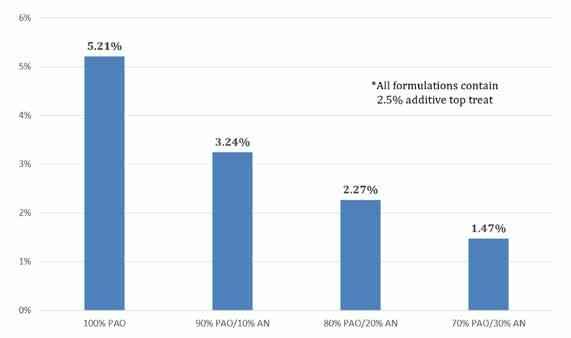
Figure 8: Panel Coker – Cured Deposit with AN-19 Base Oil Replacement
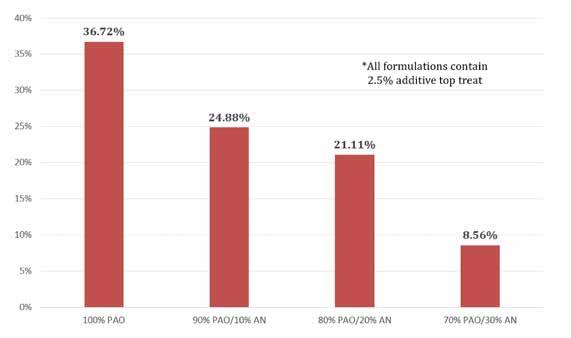

Figure 10: Panel Coker – Panels After Degreasing
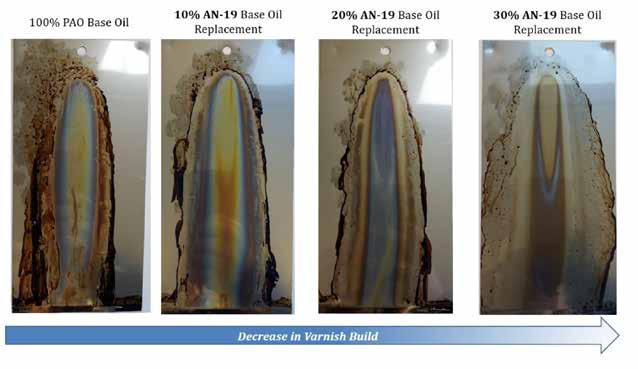
Plywood Manufacturing
A field example of a commercial conveyer belt oil containing AN-19 also resulted in excellent system cleanliness. When used for the first time in a press, the alkylated naphthalene dissolved the old deposits on drive roller friction liners that had formed from oxidation by-products of the previously used oil.
Figure 11 contrasts the friction liners before (left) and after (right) use of AN-19. The friction liners originally were coated with heavy deposits from the previously used oil. After using the AN-19 formulation for 6 months, the alkylated naphthalene completely removed the deposits and cleaned the friction liners. As a result, the oil darkened. When the darkened oil was replaced with fresh oil, there was no formation of new deposit and the oil did not darken. It was also noted that removal of deposits by the AN-19 product significantly reduced unwanted noise, vibration, and wear of the equipment, and greatly reduced maintenance cost.
Figure 11: Removal of Deposits formed from a Previously Used Oil

Friction liners before and after 6 months of AN-19 containing product use.
Greases
Several NLGI grade 2 greases were made using lithium 12-hydroxystearate, lithium complex, and aluminum complex thickeners and 10 cSt PAO blended with various levels of alkylated naphthalene.
Lithium 12-hydroxystearate Lithium 12-hydroxystearate greases were made with PAO only and PAO blended with AN-15 of similar viscosity. Use of AN-15 improved several grease properties, as shown in Table 5. Additionally, the thickener demand was reduced to 7% with a PAO / AN-15 blend vs. 12% with PAO only. Less thickener can result in improved low temperature grease properties. The PAO / AN-15 grease was also more transparent than the PAO grease, as shown in Figure 12, probably because the alkylated naphthalene acted as a bridging solvent and reduced the opaqueness of the grease.
Table 5: AN-15 vs. PAO 10 in Lithium 12-Hydroxystearate Grease


The PAO / AN-15 grease was also smoother than the PAO grease, probably because the alkylated naphthalene acts as a highly effective dispersant. The PAO / AN-15 grease also resulted in superior thermal gravimetric analysis and PDSC (Pressurized Differential Scanning Calorimetry) performance, liberating very small amounts of heat.
PDSC (ASTM D5483) testing was also conducted using greases made with lithium 12-hydroxystearate thickener and blends of PAO containing 10 and 50% AN-15. Figure 13 shows a typical temperature ramp to the test temperature, 2-minute equilibration, and a spike from opening the oxygen valve. In this test, 2 mg of grease were placed in an aluminum test pan, and the temperature was ramped at 100°C/min to the test temperature. Then, the sample was allowed to equilibrate at the test temperature for 2 minutes. The oxygen valve was opened, and the system was pressurized to 500 psi within 2 minutes. When equilibrated, the oxygen was adjusted to a flowrate of 100 mL/min. The oxidation induction time was measured from the time when the oxygen valve was opened.

Figure 13: PDSC ASTM D5483 Explanation
Figure 14 shows PDSC test results obtained at 180°C. The temperature ramp, the 2-minute equilibration, the oxygen valve opening, and the spike were clearly observed. The grease made with 100% PAO oxidized immediately and quickly. Adding 10% AN-15 to the PAO imparted oxidation resistance to the grease. And adding 50% alkylated naphthalene to the PAO imparted even more significant oxidation resistance, making the grease completely stable and equivalent to the grease made with 100% alkylated naphthalene.
Figure 14: AN-15 in Lithium 12-Hydroxstearate / PAO 10 Grease
ASTM D5483 – PDSC (180°C, 500 psi oxygen)
Norma Hoffman (ASTM D942) oxidation testing was also conducted using the lithium 12-hydroxystearate greases. In this test, five glass dishes were filled with 4 grams of test grease and placed in a pressure vessel. The vessel was sealed and pressurized to 110 psi with oxygen, and then placed in a bath held at 99°C. The pressure in the vessel was recorded at various times throughout the test.

Norma Hoffman test results followed the same trends as the PDSC testing, as shown in Table 6. The grease made with 100% PAO was the least stable and oxidized immediately and quickly. Adding 10% AN-15 to the PAO imparted oxidation resistance to the grease. And adding 50% alkylated naphthalene to the PAO imparted significant oxidation resistance, making the grease very stable.
Table 6: AN-15 in Lithium 12-Hydroxstearate / PAO 10 Grease

ASTM D942 – Norma Hoffman
Lithium Complex Two lithium complex greases were compared, one made with 100% PAO base fluid, while the other was made with a 70% PAO / 30% AN-19 blend. The lithium complex grease made with 30% AN-19 had improved properties over the grease made with 100% PAO.
The greases were also top treated with 3.35% of an additive package consisting of calcium sulfonate, alkylated diphenylamine antioxidant, sulfurized olefin / fatty oil, zinc dithiophosphate, and a tolyltriazole derivative. The additized greases showed the same performance trend with the 30% AN-19 grease, exhibiting superior performance to the grease made with 100% PAO. Specifically, the additized grease made with the alkylated naphthalene showed superior PDSC performance at 200°C, resulting in an increased induction time and reduced heat flow, as shown in Figure 15. The incorporation of alkylated naphthalene also had no negative effects on other grease properties, including cone penetration, four ball weld and wear, copper corrosion, and water stability, as show in Table 7.
Figure 15: AN-19 in Lithium Complex / PAO 10 Grease

ASTM D5483 – PDSC (200°C, 500 psi oxygen)

Aluminum Complex PDSC testing was also conducted at 180°C comparing aluminum complex greases made with all PAO base fluid and PAO blended with 10% AN-19 or 20% AN-19, as shown in Figure 16. All the greases contained 0.5% alkylated diphenylamine antioxidant. The greases made with AN-19 showed superior thermo-oxidative resistance, resulting in increased induction times and reduced heat flows, vs. greases formulated with PAO only.
ASTM D5483 – PDSC (180°C, 500 psi oxygen)
*ADPA = alkylated diphenylamine antioxidant

Aluminum Complex greases courtesy of FedChem, LLC.
Conclusions
Alkylated naphthalenes are Group V fluids that are available in a diverse viscosity range for flexibility in formulating high performance oils and greases for a variety of applications. They are typically incorporated into lubricant formulations by replacing a portion of a Group II, Group III, or PAO base oil to extend the lifetime and performance of the lubricant.
For a high temperature chain application, the addition of alkylated naphthalene resulted in less evaporation loss, better sample clarity, and superior varnish control that allowed the fluids to remain liquid and continue to lubricate.
Results obtained with an in-house panel coker test showed that incorporating alkylated naphthalene in a PAO model formulation reduced the formation of both total and cured deposits.
In a commercial plywood manufacturing application, a formulation containing alkylated naphthalene removed heavy deposits that had formed previously and also inhibited subsequent formation of new deposits.
For the various greases made using different thickeners, PAO / alkylated naphthalene blends imparted several improvements over PAO, including superior thermo-oxidative stability, less thickener, better transparency, and smoother texture.
Acknowledgements
This paper was based on a presentation given at the 86th Annual NLGI Meeting, June 8-11th, 2019, at JW Marriott Resort, Las Vegas, Nevada, USA. That presentation was awarded the Best Technical Paper at the 21st NLGI-India Chapter Lubricating Grease Conference, February 7-10th, 2019, at Hotel Taj Vivanta Guwahati, Assam, India, and granted an honorary slot at the 2019 NLGI Annual Meeting.
References
1. Hunter, M.E. 2017. “Alkylated Naphthalenes.” In Lubricant Additives - Chemistry and Applications, 3rd Edition, edited by L.R. Rudnick, Chapter 22. Boca Raton, FL: CRC Press, Taylor and Francis
2. Hunter, M.E. 2015. “Alkylated Naphthalenes.” NLGI Spokesman, Vol. 79, No. 2, (May/June): 26-43
3. Hourani, M.J., Hessell, E.T., Abramshe, R.A., and Liang, J.G. 2007. “Alkylated Naphthalenes as High Performance Synthetic Fluids.” Tribology Transactions, Vol. 50: 82-87
4. Luo, S., Ho, S.C. , and Wu, M.M. 2020. “Alkylated Aromatics.” In Synthetics, Mineral Oils, and Bio-based Lubricants - Chemistry and Technology, 3rd Edition, edited by L.R. Rudnick, Chapter 8. Boca Raton, FL: CRC Press, Taylor and Francis
Warm Welcome to our New NLGI Member
Savant Group Technical USA
Advertiser’s Index
ERGON, page 27
ILMA, page 69
Lockhart Chemical Company, page 59
Lubes’n” Greases, page 65
Patterson Industries Canada – a Division of All-Weld Company Limited, page 61
ProSys Servo Filling Systems, page 60
Vanderbilt Chemicals, LLC, IFC
Warren Oil Company, page 69





